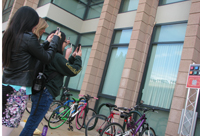Phone Camera Project May Help Manage Cultural Heritage Sites
January 22, 2013An undergraduate research project by two computer science students could help in the management of national monuments and cultural heritage sites by monitoring visual changes over time.
Rohitashwa Bagaria ’14 and Kim Merrill (Pomona) are studying cell phone camera photos taken by fellow students and others of a color tile kiosk outside the Olin Science Center at Harvey Mudd College.
They plan to reverse engineer the image processing software on the different mobile devices to access the raw data captured by each phone’s camera lens.
“We have several color tiles whose raw color values we know. We compare the color values of the images received to those raw values,” said Bagaria. “These real-color images are comparable for different cameras, since the raw colors captured by any camera lens is the same. We can use this data to compare changes in the images of monuments taken at different days. This information would be valuable to archaeologists trying to preserve a monument.”
The ultimate goal is to place at cultural heritage sites kiosks, which invite tourists to take photos of the monument and the kiosk tiles and then email the shots to a designated address for collection and study. The data will let conservators and site managers develop a long-term image dataset that provides quantitative measurements. They can measure rates of change and evaluate restorations and repairs in real-time. At the moment, there is very little data like this available.
“To make the data useful, it needs to be calibrated, and this project is part of that process,” said Gregory Bearman, the students’ technical advisor. An expert in applying electronic and spectral imaging to archeology, Bearman is president of Snapshot Spectra and imaging lead for the Israel Antiquities Authority.
“The students had to learn about color spaces and color theory, and they had to write Matlab code and do linear algebraic stuff they study in school in order to do this work. But the benefit for them is less what they do specifically and more about what they learn doing something that is open ended,” said Bearman. “There’s a big difference between doing coursework and having someone say, ‘here’s a real problem, now solve it.’”
The project is being conducted as part of HMC’s computer science course, Independent Study in Cultural Heritage Conservation Science.

